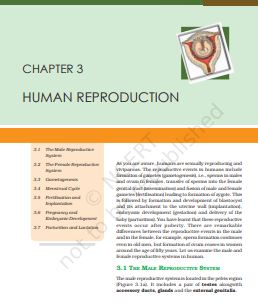‘NCERT Solutions for Class 12 Biology Chapter 3‘ PDF Quick download link is given at the bottom of this article. You can see the PDF demo, size of the PDF, page numbers, and direct download Free PDF of ‘Ncert Class 12 Biology Chapter 3 Exercise Solution’ using the download button.
NCERT Class 12 Biology Textbook Chapter 3 With Answer PDF Free Download

Chapter 3: Human Reproduction
As you are aware, humans are sexually reproducing and viviparous.
The reproductive events in humans include the formation of gametes (gametogenesis), i.e., sperms in males and ovum in females, transfer of sperms into the female genital tract (insemination), and fusion of male and female gametes (fertilization) leading to the formation of zygote.
This is followed by the formation and development of blastocyst and its attachment to the uterine wall (implantation), embryonic development (gestation), and delivery of the baby (parturition).
You have learned that these reproductive events occur after puberty.
There are remarkable differences between the reproductive events in the male and in the female, for example, sperm formation continues even in old men, but the formation of ovum ceases in women around the age of fifty years.
Let us examine the male and female reproductive systems in humans.
The testes are situated outside the abdominal cavity within a pouch called the scrotum.
The scrotum helps in maintaining the low temperature of the testes (2–2.5o C lower than the normal internal body temperature) necessary for spermatogenesis.
In adults, each testis is oval in shape, with a length of about 4 to 5 cm and a width of about 2 to 3 cm. The testis is covered by a dense covering. Each testis has about 250 compartments called testicular lobules (Figure 3.1b).
Each lobule contains one to three highly coiled seminiferous tubules in which sperms are produced. Each seminiferous tubule is lined on its inside by two types of cells called male germ cells (spermatogonia) and Sertoli cells (Figure 3.2 ).
The male germ cells undergo meiotic divisions finally leading to sperm formation, while Sertoli cells provide nutrition to the germ cells.
The regions outside the seminiferous tubules called interstitial spaces contain small blood vessels and interstitial cells or Leydig cells (Figure 3.2).
Leydig cells synthesize and secrete testicular hormones called androgens. Other immunologically
competent cells are also present.
The male sex accessory ducts include rete testis, vasa efferentia, epididymis, and vas deferens (Figure 3.1b).
The seminiferous tubules of the testis open into the vasa efferentia through the rete testis. The vasa efferentia leave the testis and open into epididymis located along the posterior surface of each testis.
The epididymis leads to vas deferens that ascend to the abdomen and loop over the urinary bladder. It receives a duct from the seminal vesicle and opens into the urethra as the ejaculatory duct (Figure 3.1a).
These ducts store and transport the sperms from the testis to the outside through the urethra. The urethra originates from the urinary bladder and extends through the penis to its external opening called the urethral meatus.
| Author | NCERT |
| Language | English |
| No. of Pages | 15 |
| PDF Size | 59.4 MB |
| Category | Biology |
| Source/Credits | ncert.nic.in |
NCERT Solutions Class 12 Biology Chapter 3 Human Reproduction
1. Fill in the blanks:
(a) Humans reproduce _____________ (asexually/sexually)
(b) Humans are _____________ (oviparous, viviparous, ovoviviparous)
(c) Fertilisation is _____________ in humans (external/internal)
(d) Male and female gametes are _____________ (diploid/haploid)
(e) Zygote is _____________ (diploid/haploid)
(f) The process of release of ovum from a mature follicle is called _____________
(g) Ovulation is induced by a hormone called _____________
(h) The fusion of male and female gametes is called _____________
(i) Fertilisation takes place in _____________
(j) Zygote divides to form _____________which is implanted in uterus.
(k) The structure which provides the vascular connection between fetus and uterus is called _______
Solution:
(a) Humans reproduce sexually.
(b) Humans are viviparous.
(c) Fertilisation is internal in humans
(d) Male and female gametes are haploid
(e) Zygote is diploid
(f) The process of release of ovum from a mature follicle is called ovulation
(g) Ovulation is induced by a hormone called luteinizing hormone (LH)
(h) The fusion of male and female gametes is called fertilization
(i) Fertilisation takes place in the ampulla of the oviduct
(j) Zygote divides to form a blastocyst which is implanted in the uterus.
(k) The structure which provides the vascular connection between fetus and uterus is called the placenta
4. Write two major functions for each of the testis and ovary.
Solution:
Two major functions of each are as follows:
Testis:
- The process of spermatogenesis produces sperms through the seminiferous tubules
- Testosterone, the male sex hormone is secreted by the Leydig cells
Ovary:
- In the process of oogenesis, ovaries produce ova
- Progesterone and oestrogen, the female sex hormones are secreted
6. What is spermatogenesis? Briefly describe the process of spermatogenesis.
Solution:
The phenomenon of sperm production from the immature germ cell in males is termed spermatogenesis. The process occurs in the seminiferous tubules located inside the testes.
In this process, a diploid male germ cell or spermatogonium enlarges (in size) for the formation of a diploid primary spermatocyte which in turn goes through the first meiotic division of meiosis I.
This division is a reductional division for the formation of two equal haploid secondary spermatocytes, each of which further undergoes second meiotic division or meiosis II for the formation of two equal haploid spermatids.
Subsequently, four haploid spermatids are formed from a diploid spermatogonium. The spermatids hence produced alter to form spermatozoa(sperm) through the process of spermiogenesis.
8. Define spermiogenesis and spermiation.
Solution:
Spermiogenesis – It is the phenomenon of the transformation of non-motile spermatids to mature, motile spermatozoa.
Spermiation – It is the phenomenon where mature spermatozoa are released from the Sertoli cells into the lumen of the seminiferous tubules of the testes.
Human Reproduction NCERT Textbook With Solutions PDF Free Download
